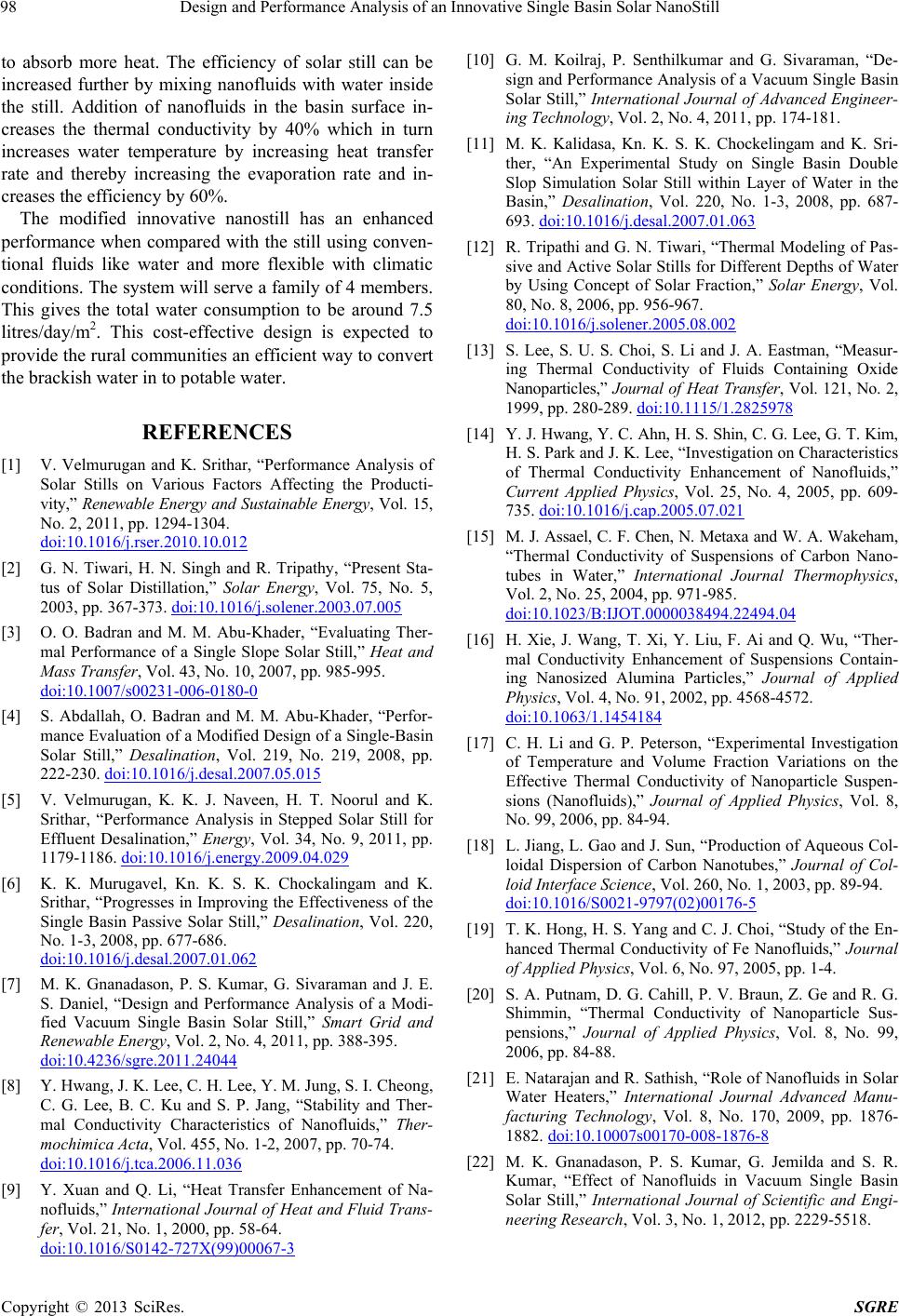
Design and Performance Analysis of an Innovative Single Basin Solar NanoStill
Copyright © 2013 SciRes. SGRE
98
to absorb more heat. The efficiency of solar still can be
increased further by mixing nanofluids with water inside
the still. Addition of nanofluids in the basin surface in-
creases the thermal conductivity by 40% which in turn
increases water temperature by increasing heat transfer
rate and thereby increasing the evaporation rate and in-
creases the efficiency by 60%.
The modified innovative nanostill has an enhanced
performance when compared with the still using conven-
tional fluids like water and more flexible with climatic
conditions. The system will serve a family of 4 members.
This gives the total water consumption to be around 7.5
litres/day/m2. This cost-effective design is expected to
provide the rural communities an efficient way to convert
the brackish water in to potable water.
REFERENCES
[1] V. Velmurugan and K. Srithar, “Performance Analysis of
Solar Stills on Various Factors Affecting the Producti-
vity,” Renewable Energy and Sustainable Energy, Vol. 15,
No. 2, 2011, pp. 1294-1304.
doi:10.1016/j.rser.2010.10.012
[2] G. N. Tiwari, H. N. Singh and R. Tripathy, “Present Sta-
tus of Solar Distillation,” Solar Energy, Vol. 75, No. 5,
2003, pp. 367-373. doi:10.1016/j.solener.2003.07.005
[3] O. O. Badran and M. M. Abu-Khader, “Evaluating Ther-
mal Performance of a Single Slope Solar Still,” Heat and
Mass Transfer, Vol. 43, No. 10, 2007, pp. 985-995.
doi:10.1007/s00231-006-0180-0
[4] S. Abdallah, O. Badran and M. M. Abu-Khader, “Perfor-
mance Evaluation of a Modified Design of a Single-Basin
Solar Still,” Desalination, Vol. 219, No. 219, 2008, pp.
222-230. doi:10.1016/j.desal.2007.05.015
[5] V. Velmurugan, K. K. J. Naveen, H. T. Noorul and K.
Srithar, “Performance Analysis in Stepped Solar Still for
Effluent Desalination,” Energy, Vol. 34, No. 9, 2011, pp.
1179-1186. doi:10.1016/j.energy.2009.04.029
[6] K. K. Murugavel, Kn. K. S. K. Chockalingam and K.
Srithar, “Progresses in Improving the Effectiveness of the
Single Basin Passive Solar Still,” Desalination, Vol. 220,
No. 1-3, 2008, pp. 677-686.
doi:10.1016/j.desal.2007.01.062
[7] M. K. Gnanadason, P. S. Kumar, G. Sivaraman and J. E.
S. Daniel, “Design and Performance Analysis of a Modi-
fied Vacuum Single Basin Solar Still,” Smart Grid and
Renewable Energy, Vol. 2, No. 4, 2011, pp. 388-395.
doi:10.4236/sgre.2011.24044
[8] Y. Hwang, J. K. Lee, C. H. Lee, Y. M. Jung, S. I. Cheong,
C. G. Lee, B. C. Ku and S. P. Jang, “Stability and Ther-
mal Conductivity Characteristics of Nanofluids,” Ther-
mochimica Acta, Vol. 455, No. 1-2, 2007, pp. 70-74.
doi:10.1016/j.tca.2006.11.036
[9] Y. Xuan and Q. Li, “Heat Transfer Enhancement of Na-
nofluids,” International Journal of Heat and Fluid Trans-
fer, Vol. 21, No. 1, 2000, pp. 58-64.
doi:10.1016/S0142-727X(99)00067-3
[10] G. M. Koilraj, P. Senthilkumar and G. Sivaraman, “De-
sign and Performance Analysis of a Vacuum Single Basin
Solar Still,” International Journal of Advanced Engineer-
ing Technology, Vol. 2, No. 4, 2011, pp. 174-181.
[11] M. K. Kalidasa, Kn. K. S. K. Chockelingam and K. Sri-
ther, “An Experimental Study on Single Basin Double
Slop Simulation Solar Still within Layer of Water in the
Basin,” Desalination, Vol. 220, No. 1-3, 2008, pp. 687-
693. doi:10.1016/j.desal.2007.01.063
[12] R. Tripathi and G. N. Tiwari, “Thermal Modeling of Pas-
sive and Active Solar Stills for Different Depths of Water
by Using Concept of Solar Fraction,” Solar Energy, Vol.
80, No. 8, 2006, pp. 956-967.
doi:10.1016/j.solener.2005.08.002
[13] S. Lee, S. U. S. Choi, S. Li and J. A. Eastman, “Measur-
ing Thermal Conductivity of Fluids Containing Oxide
Nanoparticles,” Journal of Heat Transfer, Vol. 121, No. 2,
1999, pp. 280-289. doi:10.1115/1.2825978
[14] Y. J. Hwang, Y. C. Ahn, H. S. Shin, C. G. Lee, G. T. Kim,
H. S. Park and J. K. Lee, “Investigation on Characteristics
of Thermal Conductivity Enhancement of Nanofluids,”
Current Applied Physics, Vol. 25, No. 4, 2005, pp. 609-
735. doi:10.1016/j.cap.2005.07.021
[15] M. J. Assael, C. F. Chen, N. Metaxa and W. A. Wakeham,
“Thermal Conductivity of Suspensions of Carbon Nano-
tubes in Water,” International Journal Thermophysics,
Vol. 2, No. 25, 2004, pp. 971-985.
doi:10.1023/B:IJOT.0000038494.22494.04
[16] H. Xie, J. Wang, T. Xi, Y. Liu, F. Ai and Q. Wu, “Ther-
mal Conductivity Enhancement of Suspensions Contain-
ing Nanosized Alumina Particles,” Journal of Applied
Physics, Vol. 4, No. 91, 2002, pp. 4568-4572.
doi:10.1063/1.1454184
[17] C. H. Li and G. P. Peterson, “Experimental Investigation
of Temperature and Volume Fraction Variations on the
Effective Thermal Conductivity of Nanoparticle Suspen-
sions (Nanofluids),” Journal of Applied Physics, Vol. 8,
No. 99, 2006, pp. 84-94.
[18] L. Jiang, L. Gao and J. Sun, “Production of Aqueous Col-
loidal Dispersion of Carbon Nanotubes,” Journal of Col-
loid Interface Science, Vol. 260, No. 1, 2003, pp. 89-94.
doi:10.1016/S0021-9797(02)00176-5
[19] T. K. Hong, H. S. Yang and C. J. Choi, “Study of the En-
hanced Thermal Conductivity of Fe Nanofluids,” Journal
of Applied Physics, Vol. 6, No. 97, 2005, pp. 1-4.
[20] S. A. Putnam, D. G. Cahill, P. V. Braun, Z. Ge and R. G.
Shimmin, “Thermal Conductivity of Nanoparticle Sus-
pensions,” Journal of Applied Physics, Vol. 8, No. 99,
2006, pp. 84-88.
[21] E. Natarajan and R. Sathish, “Role of Nanofluids in Solar
Water Heaters,” International Journal Advanced Manu-
facturing Technology, Vol. 8, No. 170, 2009, pp. 1876-
1882. doi:10.10007s00170-008-1876-8
[22] M. K. Gnanadason, P. S. Kumar, G. Jemilda and S. R.
Kumar, “Effect of Nanofluids in Vacuum Single Basin
Solar Still,” International Journal of Scientific and Engi-
neering Research, Vol. 3, No. 1, 2012, pp. 2229-5518.